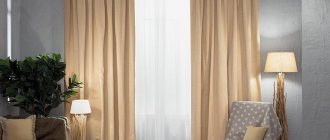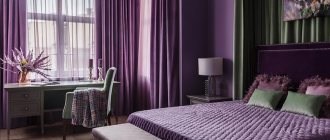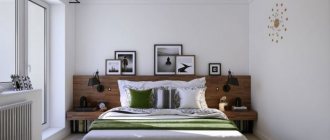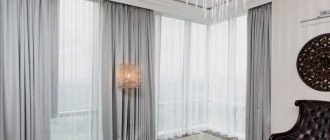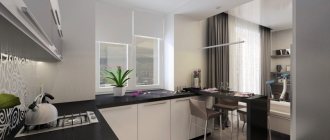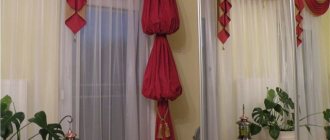Features of panel curtains
Like all types of curtains, they have their own aesthetic and functional characteristics.
- Easy to use and maintain.
- The special fastening allows them to be used not only as decoration for a window opening, but also as a partition to divide a room.
- Thanks to the multi-panel design, you can combine the canvases in any order and create stylish and interesting images.
- Thanks to their laconic appearance, they take up minimal space.
The main advantages of Japanese curtains
Japanese curtains decorate the interior and protect from the bright sun Source www.dizainvfoto.ru
Japanese vertical curtains with a floral pattern will decorate your interior Source art-interior.moscow
These curtains have numerous advantages that have made them so popular. Here are some of them:
- Japanese curtains take up minimal space, so they can be used even in the smallest spaces.
- Due to the fact that the fabric does not drape, it collects less dust - which means fewer problems for allergy sufferers and less need for cleaning.
- And when cleaning curtains is still necessary, standard household chemicals do an excellent job.
- Japanese curtains are made from a variety of materials and in different colors, and a suitable option can be selected for almost every interior.
- Most of these curtains have a very affordable price. Of course, as everywhere else, there are also premium solutions, for example, made from expensive raw materials or with an exclusive design - but everything is not limited to them.
Japanese curtains go well with a light interior Source homeli.ru
Material
Artificial and natural materials are used to make Japanese paintings.
Bamboo
They do not accumulate dust and are very easy to clean. According to Feng Shui, they absorb negative energy and prevent it from entering the house. They will fit especially well into an oriental or eco-style interior with themed design details.
Linen
Practicality and comfort. Perfect for any layout, combined with ceramics and wood, linen panels are aesthetics and harmony.
Organza
Organza curtains in Japanese style are sophistication without unnecessary details. For anyone who likes oriental exoticism, this fabric will help create the right mood in the room.
Plastic
For modern solutions, thin plastic panels have been invented. Exquisitely simple and strict. They fit perfectly into minimalist interiors, giving them a special style.
Silk
Mysterious and sophisticated. He always looks interesting and attractive. Silk curtains will make the room especially stylish.
Satin
It can be plain or with patterns. Allows you to achieve an original and unique look. Various shades and colors make it possible to choose the most suitable combination for interior decoration.
Rice paper
They let in a lot of light and give the room a special flavor, which is appreciated by many connoisseurs and lovers of Japanese style.
Blackout
Vertical panels made of this type of fabric look strict and stylish, and when unfolded, they completely isolate the space from external light.
Japanese panel material
Today, designers offer Japanese panels for every taste, so you can choose such curtains for any interior.
Rice paper
Rice paper panels look original. They are environmentally friendly. You can clean them with a vacuum cleaner.
Bamboo
Screens made of natural material are safe for health. They are light. Feng Shui experts say that this material neutralizes negative energy. Such curtains have high-quality light protection, do not attract dust, and are anti-allergenic.
Plastic
Curtains made of multi-colored plastic look original in the kitchen or loggia. When composing an ensemble, they can be arranged symmetrically or asymmetrically.
Linen
Natural material will ensure freshness in the room, will not become an obstacle to air penetration, and will protect from heat.
Linen does not accumulate static electricity, so it becomes dirty more slowly.
Organza
The material is highly durable and breathable. This amazing fabric combines mysterious transparency, airiness and lightness of the East, and discreet European elegance.
Silk
The fabric is smooth with a soft shine and bright tints. Silk panels look luxurious.
Satin
The panels retain their shape well. The fabric is made from cotton threads. Printed satin is used for screens.
Blackout
This is a special type of opaque fabric. The material has high thermal insulation properties and maintains optimal temperature conditions.
Curtain sizes
Japanese panels come only short or floor-length, all other forms are excluded.
Long
They can be either a decorative element for windows or an excellent solution for decorating niches, walls, doorways, or can be used as cabinet doors.
The photo shows long Japanese curtains in the living room interior.
Short
Translucent short curtains up to the window sill made of a plain light material are suitable for small windows. They are able to visually expand the window opening and give a feeling of abundance of space and air.
The photo shows the interior of a small bedroom with a window decorated with short Japanese curtains.
Types of fabric
It is not difficult to sew such curtains with your own hands; you can choose thick or thin fabrics. Preference should be given to natural materials. Traditionally, cotton fabrics, linen or silk are chosen. Bamboo and woven jute will help bring exoticism into your home.
First, look at examples of photos of Japanese curtains in catalogs to successfully arrange the panels. The Japanese tradition has a peaceful and calm palette of colors. Shades of cream, blue or green are ideal. Oriental laconicism throughout; an original option would be a variety of hieroglyphs or oriental images with vegetation.
A fashionable solution has become to combine several canvases of different colors. For example, white color harmonizes perfectly with colors or patterns. It is recommended to alternate plain and colored panels; a smooth transition from one color to another is possible.
Photos in the interior of the rooms
Japanese curtains provide unlimited freedom when decorating any room.
Kitchen
Most often used for spacious kitchens. They are practical, so they are ideal for this less than ideally clean room. And thanks to their laconicism and simplicity, they will fit into any design and complete the overall design of the interior.
The photo shows a kitchen decorated with brown Japanese linens.
Bedroom
For bedrooms, choose pastel and muted colors that echo nature. Cloths made from natural materials with dust-repellent properties will provide reliable protection against allergic reactions.
Children's room
When decorating a window in a nursery, you can create a special mood in the room using various prints. The design is also used to delimit a room into a recreation and play area or acts as a partition for a room shared by two children.
The photo shows a children's room and green Japanese curtains with a geometric pattern.
Living room or hall
The overall design of the products and the material are chosen to match the style of the interior. Most often, long canvases with floral or geometric patterns are used. Sometimes the panels are combined with other curtains; such compositions go well with living room interior items.
Balcony and loggia
Protect from sunlight and strong heat. The choice of color and ornament can influence the perception of the geometry of the balcony. Light shades will expand the space, dark shades will make it smaller and more comfortable.
Interior
Japanese panels are not only utilitarian and beautiful curtains; they are also used to create sliding partitions or replace interior doors and partitions.
Wardrobe
It will allow you to solve several problems, in particular, to elegantly close the entrance to the dressing room, use thick curtains instead of a screen, or fence off an area for placing a mirror.
For bay window
Smooth canvases of Japanese curtains in the design of a bay window occupy a minimum of space and do not overload the interior of the room.
How to choose the texture and color of fabric?
The Japanese themselves traditionally prefer discreet natural colors, prints in the form of cherry blossoms or bamboo shoots, and natural, loose materials: silk, linen, jute.
Naturally, in order for such curtains to fit into various interiors, they must correspond to the design concept of the room. Therefore, Europeans adapted their colors to suit their mentality, and today there are no special restrictions when choosing the pattern and color of fabric for Japanese curtain panels. They can be plain, contrasting, with a floral print, striped, checkered or even with a city landscape.
The density of fabric for screen panels can also vary. Most often, the window is decorated with two or three pairs of canvases approximately 60 cm wide. Cloths made of transparent fabric that perform the function of tulle are placed closer to the window; canvases made of denser material are placed in front of them. They replace curtains.
If the living room is not planned to be completely blocked from the sun, only translucent panels are installed.
Screen curtains made of transparent fabric, mounted in two rows, look stylish and unusual. Plain canvases are placed closer to the window, and canvases with prints are placed in front of them.
As the Japanese say: “The power of simplicity lies in the unlimited possibilities it opens up.” Behind the apparent external simplicity of Japanese fabric panels hides a wide field for creativity and imagination. They have only one significant drawback - they do not tolerate crowded spaces. But when decorating spacious living rooms, the possibilities of these curtains are inexhaustible.
Color spectrum
Japanese paintings will look even more harmonious in the interior if you choose the right one, not only the texture, but also the color.
Brown
Multifaceted, rich, but at the same time neutral color. He is not dominant. Brown color is a natural shade that is suitable for elegant and solid interiors.
Grey
In order not to end up with a too dull and conservative atmosphere in the room, when choosing this color you need to know a sense of proportion and carefully think through each shade and color combination.
Green
The color of calm, imbues the space with a natural theme. Green Japanese curtains create a positive perception of the outside world and the interior as a whole.
The photo shows a white dining room and green Japanese paintings on the windows.
White
This is a sign of excellent taste and grace, because it goes well with any interior and color of furniture, and also gives the living space a festive look.
Black and white
The pinnacle of classics, the absolute peak of harmony. Combines with a variety of bright or muted interior palettes. The black and white combination gives the design a strict laconicism and an incredibly luxurious look. It can become both a background and an accent.
Violet
A stunning, deep, rich and incredibly picturesque color that undoubtedly attracts attention.
Pink
Mobilizes and tones, provides ample opportunities to express your taste. It can induce a dreamy mood and is good for relaxation.
Beige
It will fill the design with a special aesthetics, add completeness and allow you to add more coziness and comfort to a cool or dark interior.
The photo shows a living room in light colors with beige Japanese curtains on the window.
Japanese curtains in the kitchen: practical and beautiful
Among the large number of types of curtains offered on the market, Japanese panels have long been unrivaled in many respects. If your kitchen is decorated concisely and naturally, its design includes features of minimalist or ecological styles, they will inevitably become a highlight and a worthy completion of its interior.
We offer you a selection of photos with design ideas for Japanese curtains in the kitchen, as well as tips for choosing.
Drawings and design of curtain panels
They give a special atmosphere and allow you to further emphasize the idea of style.
See how roller blinds look in the interior.
Plain
The traditional and laconic version does not draw attention to itself and does not stand out from the general background. Most often used to decorate rooms such as the bedroom or living room.
Flowers and vegetation
Floral and plant patterns give a feeling of calm. For example, in Japan, an orchid in the interior creates an atmosphere of peace and influences the perception of space, highlighting the advantages and hiding the disadvantages of the interior.
Openwork
These delicate, filigree patterns are well suited for a room such as a bedroom. They will make it more soaring, cozy and truly exclusive.
Sakura
Japanese cherry trees depicted on canvases will create a unique blooming effect in the room. Thanks to their delicate shades, curtains with sakura will look most harmonious in an interior made in brown, beige, turquoise or gray.
With transparent middle
An elegant transparent middle, combined with dense side parts, will support the overall style of the room. This option is suitable for rooms that do not need to be hidden from ultraviolet rays.
Geometry
The diversity of this pattern allows it to be used in completely different rooms. Abstraction, stripes and strict squares will fit well into the minimalist design of a small room and add spaciousness and originality to it.
The photo shows Japanese curtains with a geometric print in the interior of the office.
Photo print
They resemble screens and look like photo curtains, so realistic drawings look great on them. They help create a non-trivial and memorable interior.
How Japanese curtains work
The photo of Japanese curtains shows that they differ significantly from curtains of other styles. Curtains of this design are represented by screen panels, attached using a special holding mechanism.
The kit also includes a weighting agent. This design allows you to use curtains with maximum comfort.
For high-quality copies, all components must meet the following criteria:
- reliability;
- wear resistance;
- functionality.
DIY Japanese curtains are an original compositional element, materialized in a fashionable color palette using advanced technologies.
Here are the main nuances of Japanese-style curtains:
The principle of operation is similar to the principle of operation of blinds. The width of a sectional panel can be up to 1 m.
The curtains are controlled using a cord and chain. The canvas moves according to the screen principle, which is very convenient.
For sewing, materials of exclusively natural origin are used - linen and cotton fabric, silk, rice paper, bamboo. It is allowed to add artificial fibers to the composition of the fabric.
The predominant color palette is pastel. Monochrome is not necessary. A drawing is acceptable.
The panels are fastened using runners.
The cornice is made of metal strips equipped with holders. Can be attached to both the ceiling and the wall.
The fabrics are smooth, without gathers, tiebacks, garters or clips. Supplemented with a straightener - a device that allows the product to be even and smooth.
Japanese-style curtains give freedom of imagination and allow you to create a truly irresistible interior. At the same time, they do not overload it.
Moreover, such window design brings freshness and exclusivity to the environment. His creative potential is enormous - using Japanese curtains, you can achieve a unique design in various textures and colors.
Style decision
Also, these canvases can organically and beautifully fit into different interior styles.
Ethnic style
Rich colors, various patterns and ornaments are the main defining features of this style. The main thing is that the selected curtains are combined with the overall interior of the space. Natural materials and light transparent products are suitable.
The photo shows a room in an ethnic style with windows decorated with Japanese paintings.
Minimalism
The emphasis here is on the abundance of light and space. Therefore, special attention is paid to the selection and design of curtains. The modesty and unpretentiousness of the curtain panels are quite consistent with the spirit of this style.
Oriental
The interior should be as natural as possible, dividing the space with miniature screens, a minimum of furniture, straw mats and an abundance of accessories.
The photo shows the interior of a living room in an oriental style with Japanese curtains on the window.
Eco
This style does not use heavy and expensive fabrics. Canvases in neutral shades or Japanese jute curtains look especially harmonious.
Modern
The modern style features laconic lines and clear forms, as well as glossy textures, metal details, rough wood and smooth leather. Japanese window panels are suitable here, since the absence of draperies gives them a particularly neat and compact appearance.
High tech
The uniqueness of this style is in its rigor and functionality. Japanese curtains with geometric prints will emphasize the progressiveness of views, the modernity of the interior and will resonate in decoration or pieces of furniture.
Interior style for panels
Panel curtains are necessary in traditional Japanese design; they act as an expressive detail in the interior of high-tech, minimalism and avant-garde styles. By emphasizing functionality, they can add elegance without making the space feel cluttered.
The presentation of the simplicity of Japanese style in interior design is only an appearance. Everything needs to be carefully thought out and logical accents made to achieve elegant asceticism.
All details must be in the same style. Japanese curtains, as an original detail, are suitable for anyone who wants to bring originality and exoticism to the interior without much effort and expense, or simply hide something from prying eyes. As an option, the photo shows a niche decorated with screen curtains.
Japanese curtain effectively hides a niche
The ladder panels look beautiful on the kitchen window
The photo shows an example of kitchen design
Japanese style panels in a small kitchen
Japanese curtains look great in spacious rooms with large windows (living rooms, bedrooms, kitchens). It is better not to hang one panel on narrow window openings - visually they will appear even smaller.
From a Japanese-style room it is necessary to remove massive furniture with a large number of shelves, drawers and other excesses. Housewives with experience in crocheting can make poufs for the floor, which will be a wonderful addition to the decoration of the living room.
Knitted poufs in the interior
If you need to close a niche or make a space partition, Japanese curtains will be a good solution. When installing panels in a one-room apartment, you can create a living room and a bedroom.
In the nursery, using a curtain-screen partition, you can create space for sleeping, studying, and playing. In the bedroom it will be a boudoir.
A partition in the kitchen will allow you to differentiate it into a “dining room” and a place for cooking. The models are practical, simple and will come in handy in any kitchen.
To present the Japanese style in the bedroom, you can use 2-3 panel curtains in soothing colors, harmoniously combined with each other. One of them may depict a traditional Japanese landscape.
According to ancient Japanese teachings, thoughtful contemplation is calming and leads to inner harmony. In addition, if you have insomnia, counting sakura flowers is much more pleasant than counting sheep jumping over a fence.
For a kitchen room, Japanese curtains of catchy colors with sharp contrasts and bright prints are undesirable. According to the Japanese culinary tradition, complete concentration on the process of preparing dishes or absorbing food is required.
You can combine models from several screens consisting of light and dense fabrics or use smooth and textured material, as well as traditional bamboo and straw. For small rooms, models of curtains up to the window sill are suitable, and for spacious rooms – panels up to the floor.
In the kitchen, it would be more practical to choose synthetic fabrics for curtains. They remove grease stains and cooking odors more easily.
An excellent solution would be to choose natural colors for a Japanese-style kitchen - moss, peat, leaves, stone. Japanese curtains with floral prints in cheerful shades combined with rich plain fabrics are suitable for a child's room. For the living room, instead of blinds, you can use a combination of Japanese curtain panels with organza and tulle.
Options for combining Japanese panels
Japanese paintings unconditionally decorate the entire room and also have successful combinations and combinations.
With curtains (tulle, veil, etc.)
Light and translucent curtains look great in combination with Japanese curtains. It is possible to combine even several types of curtains on one window.
Various lengths
A great way to give your home a unique look without breaking the bank. This option is suitable for decorating a window with a balcony door.
Multicolored
They set a special mood for the entire interior and make the room bright and individual.
Japanese panel curtains - room for design
A variety of models and types of Japanese curtains will allow you to take into account the taste of everyone. A wide range of materials and colors are used to make such curtains and blinds. Various textured combinations look good - alternating organza and opaque fabrics, a light veil and thick curtains. A multi-level cornice allows you to fit about 10 panels, which will allow you to change the interior in a matter of seconds.
Japanese curtains softly diffuse light; with their help, you can create a loft-style design using white panels through which light from the balcony will softly shine into the living room or kitchen.
Japanese roller blinds are an ideal option for fabrics with complex patterns. The fabric never bunches up, so you and your guests can admire the beautiful look of the curtains. Any prints, patterns and colors can be used. Using thermal printing, you can design curtains with your own individual design, boldly mixing colors and textures. Modern designers manage to combine Japanese curtains with traditional curtains in living rooms.
Living room
When decorating a living room, it is important to remember that this is the calling card of your home. Here you can choose both bright colors and calm pastel tones. A good solution for the living room is a transparent middle and dense panels along the edges. But this option is not suitable for a room with a south-facing balcony that needs to be protected from bright daylight.
Kitchen
For the housewife, the kitchen is the main room in the apartment. This is where she spends the most time; this is where the whole family has breakfast, lunch and dinner. Curtains for the kitchen should be made of high-quality fabrics; it is advisable to choose a simple and laconic design. For a small kitchen, you can choose translucent panels made of light fabrics; they will visually add space and air. If we talk about the psychology of color, then warm colors have a good effect on appetite: yellow, red, orange.
Bedroom
In the bedroom you need to create a pleasant twilight, dim lighting. To do this, you need to think about what texture and color are suitable. Pastel colors in combination with dark shades, for example, matching the bedspread, are good for the bedroom. Bamboo curtains look unusual.
Non-standard use
Japanese curtains are universal. They can be used not only in decorating a window opening.
As partitions
Sometimes multifunctional rooms need zoning of space. For example, a kitchen combined with a dining room, or a bathroom combined with a toilet. With the help of Japanese panels, you can easily and conveniently divide such rooms into independent sections.
See more examples of how to effectively use Japanese curtains to divide a room.
The photo shows a living room combined with a kitchen and Japanese panels as partitions.
Instead of cabinet doors
This option is suitable for saving space in small bedrooms. They do not clutter up the room and look weightless.
In what kitchens are Japanese curtains appropriate?
The photo shows an example of combining Japanese curtains and light curtains with eyelets.
Unfortunately, Japanese panels are not suitable for all rooms and design styles. Therefore, before you go to the store, you will have to analyze whether they will be appropriate in your kitchen.
The photo shows a good example of a combination of Japanese and Roman curtains in a kitchen interior.
Japanese curtains are not suitable:
- For small and cramped spaces and small windows. Their refined brevity in these cases will look more flawed than elegant. If you really like Japanese curtains, but the size of the kitchen does not allow you to decorate the window with them, try attaching them at the entrance, instead of the door, or use them as a screen (for example, to separate the work area from the relaxation area).
- For lush and pompous interiors with a lot of additional details and decorations. Japanese curtains will get lost against the backdrop of an abundance of textiles, intricate decor and elaborate furniture. Baroque and Rococo, Provence and Country, Empire and Romanticism are absolutely contraindicated for them.
Japanese curtains are suitable:
- For spacious rooms with large windows. If the size of the kitchen is impressive, but the window is small, such curtains extend beyond it. This technique visually increases the window space. If the kitchen is small but the window is large, you can adjust the length of the curtains by shortening them to the window sill. Such curtains will not “absorb” the wall and visually it will appear wider.
- For discreet, minimalist interiors. Japanese curtains will fit beautifully and organically into Japanese, Scandinavian, hi-tech, loft and similar interior styles. They will further emphasize their elegant simplicity, which includes everything necessary and does not tolerate anything superfluous.
Types of cornices
Before decorating a room with curtains of this type, you should first decide on the choice of cornice.
Tire
Convenient option, mounted on a wall or ceiling. They can be two, three, four or even five rows.
Tubular
A classic and universal option for all interiors. Made from plastic, metal or wood. Curtains are attached to the cornice using rings or fabric loops.
Types of control
For ease of use, there are several types of control for Japanese curtains.
Manual
The movement of the canvases is done by hand, without the use of additional devices. When the control panel moves, the remaining canvases also begin to move. Using the “free” option, you can move each panel individually.
Cordoba
Control using rope or cord. It does not make the curtain structure bulky and allows you to conveniently and easily regulate the flow of light in the room.
Using a rod
Looks like it's manual. When the control panel moves, the remaining panels also move. Allows you to control the curtain structure without touching the fabric.
How to attach?
When installing, you need to take into account all the nuances. After all, nothing should interfere with the free movement of the panels. Step-by-step instructions for attaching curtains:
- Select a cornice of suitable width and install it in the desired location.
- Attach curtain brackets to the curtain rod.
- Hang the required number of Japanese panels. Their number depends on the chosen type of cornice.
- Attach special weights to the canvas to prevent unwanted folds from forming.
- Check the functionality of the mechanism and the curtain structure as a whole.
Japanese curtains in the interior: a subtle sense of style (24 photos)
The sophistication of Japanese minimalism has earned him worldwide fame. This interior style amazingly combines conciseness and sophistication, simplicity and grace.
Since modern interior fashion welcomes eclecticism and an original interpretation of ethnicity, decorative solutions from the Land of the Rising Sun can now be found in a wide variety of settings - from high-tech to updated classics. Among these solutions are Japanese curtains: panels that designers use to effectively decorate windows and zone space.
Do you also like Japanese curtains and are you thinking about how to organically fit them into the interior of your living room, bedroom or kitchen? Study the photographs in our selection and take advantage of the advice of professional decorators who have created amazing interiors with Japanese panels.
